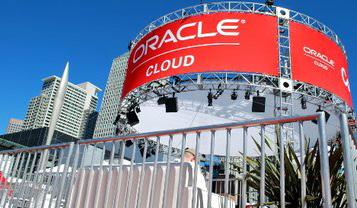The Hybrid IT Supplement

Capacity management on and off prem
An operatic movement
> How the Royal Opera House survived the pandemic and embraced hybrid IT
Traveling to the cloud
> Travelex bounces back from a ransomware attack, and rebuilds in the cloud
The cloud, on-prem
> Vodafone needed a cloud, but at its own data centers. Here’s what the telco did
Sponsored by
INSIDE
Let’s create Data Centres of the Future — together.
Enable efficiency and agility at every stage of your data centre’s lifecycle. Partnering with Schneider Electric brings you a connected infrastructure of hardware, software, and services. And with sustainability at our core, we’ll help accelerate your progress toward a net-zero future.
se.com/datacentres

Sponsored by
Contents
Best of both worlds
Over the years there has been a massive influx of companies migrating their IT infrastructure to the cloud.
While this seems to offer more flexibility and potential CapEx savings, the reality is that switching over masses of apps and data sets isn’t as simple as one might hope.
Some applications are just not cloud-friendly, while other restrictions such as data sovereignty, security, and even just the costliness of making the move can limit the feasibility of becoming a fully cloud-based company.
Faced with this, many enterprises are exploring various hybrid IT methods to make the most of the cloud, on-premise solutions, and colocation hosting.
Perhaps instead of the big cloud push, we should be looking at the drive for hybrid IT.
Singing the praises
Live venues were hit hard by the Covid-19 pandemic, and for those who wanted to stay afloat, they needed to quickly generate a means of income without having an actual audience in attendance.
But for London's Royal Opera House, a company that has literally been burned to the ground multiple times, it couldn't let this be the end.
Like many venues, the opera house created a streaming platform, uploaded decades of recorded performances, and went digital - something that simply couldn’t have been achieved with the venue’s previous IT setup.

After months of board room discussions, expert opinions, and business proposals, the company
decided on a hybrid IT solution, one that saved them during the pandemic and opened the venue and the art of opera up to new and unexpected customers.
Back from the brink
Foreign exchange company
Travelex had a particularly challenging 2020. Faced with a pandemic and the aftermath of a $6m cyber attack, the company ended up in administration.

Fortunately, after PwC took over multiple subsidiaries and completed a debt restructuring, the company began the process of building itself back up.
As an international company that acquired many subsidiaries over the years, they were left to sort through a complex maze of data center sites, replicated and redundant workloads, and a vast variety of applications.
Ultimately, the company opted for a hybrid approach, combining colocation, on-premise, and cloud computing. Rest assured that security became a key concern in the new deployment.
The cloud lives on-premise

For many companies, hybrid IT looks like hosting in a variety of locations, sometimes a hybrid approach is about merging those locations together.
An on-premise cloud is a counterintuitive concept but is an increasingly popular solution.
Take Vodafone, a customer of Oracle’s Dedicated Regions, which has been able to cash in on the perks of the cloud without ever leaving their own data centers.
Could on-prem cloud be the answer to the hybrid IT question?
The Hybrid IT Supplement | 3
4
10
4. Inside the Royal Opera House How a major live venue is using hybrid IT to reach the masses
10. Digital transformation in the wake of a cyber attack Travelex was held ransom, so they took control of their IT infrastructure
13 Hybrid IT
13. Bringing the cloud on-prem A look inside the Vodafone-Oracle OCI relationship
The Phantom of the Opera is live, and available on-demand
Georgia Butler Reporter

The Royal Opera House has been an iconic fixture in London, England, for close to 300 years. Its grand exterior, matched only by the domed theater within, was a regular haunt for the capital’s bourgeoisie. But the company no longer wants that air of exclusivity. The Royal Opera House (ROH) wants to welcome the masses with open arms, and make the venue appealing for all.
To help broaden opera and ballet beyond its classically ‘elite’ audience, the ROH hopes that data centers will be able to help.
Given its lengthy history, the ROH has been through several metamorphoses. Its first rebuild occurred in 1792 after a fire destroyed much of the auditorium, the second in 1857 after it burned down again.

4 DCD Supplement • datacenterdynamics.com
How a cloud-first hybrid-IT approach is making opera more accessible to the public
The Hybrid IT Supplement
In 2014/2015, the ROH underwent its first infrastructure refresh by migrating much of its IT into two colocation data centers, and deploying a wireless access network. While this saw an improvement performance-wise to the previous setup where all compute was hosted at the venue, by 2018 the company was beginning to resent the inflexibility of its IT stack.
2019 saw the commencement of plans to rejuvenate the ROH’s IT infrastructure and move much of it to the cloud, bringing about the fourth metamorphosis. While plans were already in place, they were drastically sped up due to the pandemic.
After the bulldozer of Covid hit, venues were left to pick up the pieces. The pandemic even necessitated the ROH to sell a Hockney painting for £12.8 million ($16.2m), just to help keep it afloat.
That latest rebuild saw the ROH take its relationship with Amazon Web Services (AWS) to the next level, and a lot of its IT go off-premise.
Moving (partially) to the cloud
“We’ve been working with AWS on a digital transformation plan and hosting the majority of our applications
and infrastructure in the cloud for about two or three years,” said James Whitebread, CTO of the Royal Opera House.


“We've got a number of business demand needs across the organization, for which we've broken into four sections: customer experience, back of house (which is essentially powering the front of house customer experience), enterprise applications, and core infrastructure.
“In total, that transformation is currently at about 20 projects, which will continue to roll across the years, and many of those projects are cloud platform enabled.”
The move to a cloud-first hybrid IT setup really ramped up at the same time that the long-term integrity of live venues began falling apart. They were universally decimated by the pandemic’s restrictions which prevented people from going within two meters of one another.
Even after regulations were lifted, many were still terrified of being in an enclosed space with another living and breathing being.
Whitebread noted that this era forced a new approach to the consumption of Opera and Ballet.
“During the period of Covid, we did a lot of streaming via our ondemand video platform. We still do some streaming including a cinema screening once a month where we stream up via satellite and then distribute throughout the cinemas.”
Notably, the ROH has been able to digitize the storage of decades of performances. According to Whitebread, prior to this, they were storing tens of thousands of video assets on video tapes, data tapes, or hard drives that were scattered across the building, sometimes taking days or weeks to track down.
Those assets have now been uploaded to the cloud via AWS Snowflake, and where necessary, converted into a digital file. This remains an ongoing process, particularly with those files that are not already in a digital format.
Testing proof of concepts
According to Whitebread, one of the major benefits of moving to a hybrid IT approach is that it has enabled the company to flex and create proof of concepts (POCs) that can be quickly tested and scaled. An example of this is the AWS-based media asset platform.
The Hybrid IT Supplement | 5 The Hybrid IT Supplement | 5
The Hybrid IT approach
That on-demand video platform would have been hard to pitch previously – the investment in onpremise IT would have been huge and hard to experiment with, and while there’s an obvious value in sharing content, it would need to outweigh the costs.
“We want to be really accessible,” said Whitebread. “We have a core customer base who, naturally, enjoys the art form, but we wanted to outreach to other customers, to involve as many people in [opera and ballet] as possible.
“Through that streaming platform, we can reach a variety of people in both the UK and worldwide, and increase our relationship with the customer. Anyone who comes to watch a show can continue engaging afterwards, and they can watch content time and time again.”
In a Webinar with Ostmodern, the company which partnered with the ROH on its on-demand platform, Terry McGrath, director of media and audiences at ROH described how the ability to run user testing has helped them to reach wider audiences –notably younger people. They have been able to experiment with shorter content, behind-the-scenes footage, and distributing content in acts rather than two-hour-long productions.
By taking away the barrier that on-prem infrastructure can present, the ROH has been able flexibly move opera from a pursuit that can only be
accessed by those who can afford it to something that anyone can tune in and enjoy, regardless of where they are located. All they need is a device and an Internet connection.
The ROH’s cloud migration has also enabled the company to explore new technologies, Whitebread said. “There's a great opportunity around ticketing, for our customer relationship management to better target customers with artificial intelligence (AI) and machine learning,” however the company has yet to deploy any AI tools.

He added: “Data is obviously the big driver for us. We want to really understand our customers more and the relationship that we have with them. The more we understand ourselves, the better we can look to the future with our customers.”
The issue of ticketing is a fluctuating workload for the ROH. With some busy periods (notably Christmas time), the ability to scale up with ease has improved the process significantly, Whitebread said.
The ongoing role of on-premise
While the ROH has been investing heavily in AWS, not all of its infrastructure has headed cloud-wards.
When the team was first considering its IT-reboot, some were arguing for an all-cloud approach. But when it came
to actually analyzing the situation, it became apparent that it would be not only far more complicated than necessary, it would also be more expensive.
Instead, the company opted for the hybrid approach, which currently involves hosting around 10 percent of its IT on-premise, managed in partnership with Nutanix, which deployed a four-node Nutanix NX solution, capable of supporting around 30TB with 25 percent headroom.
At the time, Daniel Rubie, head of technology operations at the ROH, said: “The market evaluation dispelled certain wrongly held beliefs within ROH that it would be a case of simply lifting applications into a cloud environment. The surprising thing for some of the IT team was that the cloud options emerged as far more complex than expected and more expensive than the Nutanix solution.
“For example, cloud involved maintenance support which would mean adjusting for additional costs.”
In practice, the ROH’s remaining physical footprint is two racks of equipment on-premise, and half a rack in a managed data center. They host a number of legacy systems on that equipment, including finance systems and building management. Where appropriate, aspects are being migrated to the cloud.
“There’s a balance between what’s
6 DCD Supplement • datacenterdynamics.com
The Hybrid IT Supplement
Tottenham Hotspur - Georgia Butler
in the cloud and what we need to keep on-prem, because we are a live venue, so there is always going to need to be an element of on-premise computing,” says Whitebread.
For example, while large media files have been moved to the cloud, high-resolution production asset management and edits are still currently being handled on-premise for the time being. This will potentially change, determined by how the economics and performance adjust over time.
The ROH is also looking to develop its on-site networking.
In June, the ROH announced it was working with Telstra to develop a fixed wireless service within the building.
“Telstra is deploying hundreds and hundreds of network access points,
wireless access points, and hundreds of backend 24 or 48 port switches. They are really replacing our core network,” explained Whitebread. “We've got an aging network that's not going to scale to support the needs of the business going forward. The re-architecture should be finished by the end of this year.”
Having access to a reliable network is a general expectation now among customers, and this scalable WiFi will mean that customers get a consistent experience across the house (and will now get access to a connection in the Auditorium itself).
The on-site network is also going to improve virtual collaboration with the ROH’s international teams. Creative teams working on the shows behind the scene will be able to plan productions effectively before they
arrive at the venue.
This digital transformation effort being taken on by the ROH is bringing this somewhat archaic and out-ofreach art form to the masses, opening the auditorium’s doors to anyone who wants to get involved. But more than anything, the ROH wants to ensure that it is future-proofing itself in scalability.
“We want to make sure that we are as lean and as efficient as we can be, and that means we make sure that our infrastructure is scaling for the next five to 10 years,” Whitebread surmised.
“Whether that's on-prem networks, or on-prem software or hardware, to everything that we do in the cloud, we're trying to make sure that we scale and have an open standards approach.”
Bringing additional connectivity to venues is nothing new. But while the Royal Opera House has a capacity for 2,256 people in the audience, other larger venues will need to drastically scale this up.
For example, the recently upgraded Tottenham Hotspur stadium, can host 62,062 football fans, more than 27× the capacity at the Royal Opera House.
For such a large task, Tottenham partnered with HPE Aruba which deployed over 22,500 network points installed and 1,228km of network cabling.
Across the site, there are more than 1,670 Aruba access points – pitch side, that looks like one every 75 seats – and 700 Aruba BLE Beacons to help with wayfinding and location services inside the massive stadium.
This level of connectivity means that, hypothetically, 65 percent of the crowd could simultaneously live stream video.
Not only does this have a huge impact on the customers, Aruba is connecting everything within the stadium. From CCTV, media, energy, lighting, to the IPTV and digital
signs, e-ticketing, lifts and escalators, match day production and content distribution, everything is reliant on the network to function, then connecting to the two on-premise HPE GreenLake data centers. In total, the stadium has around 10 to 12 internal businesses running, all with different workloads.
For large venues, there is no onesize-fits-all approach, and while many are opting for a hybrid-IT approach, this can look vastly different on a case-by-case basis.

The Hybrid IT Supplement | 7
From masquerade balls to ball games
approach
Tottenham hotspur stadium - Georgia Butler
The Hybrid IT
Justify Your DCIM Monitoring Software with Our Simple Tool
It may be obvious to any IT Operations manager that monitoring software is necessary when you’re tasked with keeping tabs on all the power and cooling infrastructure across your (likely) geographically distributed IT portfolio. The monitoring and alarming functions of data center infrastructure management (DCIM) software provide visibility to all monitored devices so
that you have real-time situational awareness of device status, health, and environmental conditions (e.g., temps, humidity levels, seeing who is in the room, etc).
Without this visibility, you either pay to have trained staff at each site or you fly blind and wait for problems to pop up, greatly risking unplanned downtime. Neither option would be feasible or acceptable to most, I’m sure.
DCIM monitoring software justification tool
But the necessity of DCIM monitoring tools may not be so obvious to purchasing authorities, particularly if you’ve been getting by without it. CFOs and CIOs may expect to see an ROI analysis or understand what the payback period would be. But how do you do this credibly for a software monitoring tool

The Hybrid IT Supplement
that gives awareness of what’s going on and helps you avoid problems that might happen in the future? In other words, calculating a return on investment is difficult because quantifying the value of software requires estimating future outcomes on how your operations would change once the software is implemented.
A simple framework and value calculator
We believe the best way to handle this challenge is to use our new DCIM monitoring value framework described in White Paper 292, “Calculating ROI of DCIM Monitoring for Distributed IT Sites” and encapsulated in our freely available TradeOffTM Tool, “DCIM Monitoring Value Calculator for Distributed IT ”. Our framework will help you quantify the value and justify the investment. The tool offers a more credible prediction by giving you the flexibility to adjust costs and many other assumptions based on your specific inputs. Rather than prescribing the outcome, it provides a means for the user to experiment with “what-if” scenarios.
As shown here, the framework includes three key categories of financial value: 1) a reduction in downtime occurrences (i.e., IT service outage), 2) a reduction in staff and service costs related to power and cooling device management, and 3) a reduction in security and environmental incidents. The paper explains the key factors and variables behind each of the categories in detail.
Security and environmental risks
As for reducing the risk of security and environmental risks, our calculator tool defaults to “no impact.” This is because while DCIM can help reduce some of the risk, it does not address all the risks associated with cybersecurity, for example. Also, the cost of a single security or environmental incident can exceed the cost of the DCIM solution by orders of magnitude, making it overwhelmingly dominate in the value calculation.
For example, while a cyber breach for a small business has been reported to cost US$108k [1], the global average cost for a data breach has been reported to be as high as $4.35 million [2]. Many factors affect what this value would be for a particular site, such as how large the breach is and what data is compromised. As another example, an unnoticed water leak can cause enough damage to quickly exceed the cost of DCIM, more than justifying the entire expense of the solution.
While security and environmental damage generally
Quantifying the value of the impact of downtime through this simple formula (above).


D CIM Formula for quantifying the value of the impact of downtime.
dominates the calculation, for “what-if” planning, some companies like to include their value, as a way to point out to stakeholders the potential value of the software, as some are not aware of DCIM’s cybersecurity assessment or environmental monitoring functionality[3] For those that choose to include it, we recommend using your estimated value for a single incident.
DCIM calculator shows results
The tool (example screenshot below) presents results based on your selection of preferred cost model: perpetual license-based DCIM or subscription-based DCIM. Perpetual license involves paying a one-time upfront cost to use the DCIM software in perpetuity, but it also typically involves an annual support cost. The tool defaults to 18 percent but is user adjustable in the Advanced Inputs. Choosing “perpetual license” will calculate a five-year cashflow that shows a payback period for the investment. The subscription cost model, on the other hand, involves paying either a monthly or yearly fee to use the software without any added support cost. When a subscription cost model is chosen in the tool, it will calculate a five-year cash flow that shows an ROI percentage.
DCIM Monitoring Value Calculator for Distributed IT
Try out the calculator today and see how much DCIM Monitoring software can save your organization.

[1] https://prowritersins.com/cyber-insurance-blog/average-cost-of-a-data-breach-forsmall-businesses/
[2] https://www.securitymagazine.com/articles/98486-435-million-the-average-cost-ofa-data-breach
[3] White Paper 216, Cybersecurity Guidance for Data Center Power and Cooling Infrastructure Systems
And quantifying staffing expenses with this formula.

Schneider Electric | Advertorial
The Hybrid IT Supplement | 9
The Hybrid IT rebuild
How Travelex rebuilt its IT infrastructure for resiliency

On the last day of 2019, much of the world’s population put their problems aside for a night of celebration. The first cases of Covid-19 had begun popping up, and anxiety was spreading faster than the disease itself.

But for Travelex, Covid-19 was the least of its worries. On New Year’s Eve, the currency exchange would experience a major cyber attack, crippling the company’s business.
Ransomware-as-a-service operation REvil broke into its systems, forcing Travelex shutdown its websites across 30 countries in the hopes that doing so would contain the virus (computer, not corona), and protect their data.
10 DCD Supplement • datacenterdynamics.com
The Hybrid IT Supplement
Georgia Butler Reporter
REvil claimed to have downloaded around 5GB of sensitive customer data, including dates of birth, credit card information, and national insurance numbers, and demanded Travelex pay $6 million in ransom.
Reportedly, Travelex negotiated the fee down to around $2.3 million worth of Bitcoin, but by August 2020, the business entered administration, and appointed PricewaterhouseCoopers Ltd (PwC) to its multiple subsidiaries.

While this may seem like the story of a company’s downfall, it is actually the story of how a company changed its IT set up and saved itself from total devastation.
PwC restructured the debt, managing a deal that provided the company with £84 million ($105m) of new funding, saved thousands of jobs, and pushed ahead the company’s plan to move to the cloud.
“We already had some plans in 2019 to move to the cloud, but they weren’t really consistent and the overall story was missing. We didn’t know what that NorthStar ambition really was,” admitted Hans van der Waal, global IT director of Travelex. “Previously, our IT footprint was pretty scattered all over the place and not executed that well.”

“When 2019 started we were about to start some new activities and figure
things out, but Covid came in and had a deteriorating effect on our business. Travelex is very dependent on people traveling, and as you can imagine that was pretty limited in 2019 through 2020 and 2021. But this gave us a window, after the cyber incident, to really figure things out and position our strategy in a way that would reduce costs.”
At the time of the attack, Travelex was functioning out of enterprise data centers spread out across the globe, and as the company continued to grow, these became an unnecessarily complicated web of cables, data, and processes.
The company had three pairs of data centers in three continents. Now, all that remain are two data centers, an enterprise facility in the UK and a colocation data center in Sydney, Australia, which support the company’s networks, older file shares, telephony solutions and legacy applications which are due for retirement.
“Historically, the company was built on very localized solutions. The team in Asia had its own system developed, and again in the UK or Europe. But then things were brought in via acquisitions and we ultimately had a very complex IT estate with a lot of overlap.
“If we wanted to change something, for example how we do a compliance check, that would need to be replicated in multiple places every time.”
Ultimately, it was decided that a centralized system made far more sense, and Travelex began the process of moving to the cloud. In this case, they chose to use Amazon Web Services (AWS).
In order to do that, Travelex had to go through every system, weed out the ones that were duplicated, find those that could be retired and those which could be morphed into applications, and begin making them cloud friendly.
“We basically did a rationalization,” explained van der Waal. At this point, around 90 percent of Travelex’s enterprise systems have now been moved across to Amazon Web Services (AWS) and, of course, Travelex has employed the highest security solutions AWS offers.
“We wanted to morph CapEx into OpEx, while making things more open and integratable. We definitely improved our
Microsoft The Hybrid IT Supplement | 11 The Hybrid IT rebuild
risk posture by making these changing.”
The process was not cheap, however. The legacy systems which Travelex moved to the cloud were not designed in a cloudnative way, so it has been expensive to migrate them, and their consumption remains high. But, overall, it was the more cost-effective strategy.
To do this, Travelex had to take a full copy, and load and test it in destination, reconfigure the connections and linkages across the estate and then close the application on premise. It may sound like a simple process, but this came with detailed run books that required the company to follow very specific tests.
Travelex started with the lower environments and, as they got more comfortable with the process, began migrating production workloads. In total, Travelex did around 30 cutovers in the period of a year.

A key proportion of Travelex’s IT remains either on-premise or in the company’s colocation sites. For example, Payment Card Industry data (PCI): The Payment Card Industry Data Security Standard applies to all major card brands and has six categories of requirements for compliance – to build and maintain a secure network and systems, protect cardholder data, maintain a vulnerability management program, regularly monitor and test networks, and maintain an information security policy.
While Travelex does this on-prem, van der Waal says it could be done on the cloud, though notes that it would be essential that you “take additional measures.”
In other cases, the move to the cloud was complicated by regulatory requirements. The company experienced particular issues in China.
The China Banking and Insurance Regulatory Commission (CBIRC) requires cloud providers to agree to regular reporting on the services for the bank, any emergencies, cooperation with CBIRC investigations, strict client confidentiality and to not carry out activity in the name of the bank.
Travelex had to balance these requirements with having the level of latency necessary to run operations.
“Regulators are themselves an issue,” explains van der Waal. “The regulations in China are quite tough, and we have an operation in China so we hosted that business in a Chinese data center. We moved some of this to the cloud with AWS, but the initial designs didn’t comply with regulations surrounding data protection and how we paid for requirements in the China location. We managed to find network provider checkpoints and a design that would work from a performance, cost and security perspective while satisfying regulations.”
While the cyberattack was not the sole motivator for to Travelex’s move to a cloud-first hybrid IT approach, it did play a significant role. But it is important to note that the cloud is not an inherently more secure option. It’s not about where you store the data, but how you go about protecting it.
Ariel Parnes, co-founder and COO of Mitiga, a cloud-specific cyber security company spoke to DCD about the reality of cyberattacks for companies. As someone who spent 23 years working for the State of Israel and running state-sanctioned cyber-invasions, Parnes has a lot of experience from both the side of those trying to protect data, and the individual attempting to gain access to it.
“It’s a constant competition between the attacker and the defender, and it will never end,” said Parnes.
“With an on-prem environment, the perimeter is very clear. You know where it starts and it ends, and you are the owner of that environment all the way. In the case of a cyber-attack, you would send a team to look for the fingerprints left behind to understand what happened, how that attack impacted your software, firewall, EDR, etc.
“But when you are with the cloud, you are sharing responsibility. Some of the responsibility lies on Amazon to make sure that their environment is secure. You do not own your data in the same way in this case: Amazon owns your data – the fingerprints, the telemetry, the forensic data. So, to investigate these attacks, you need to have already prepared your relationship with that provider, or you will be managing the situation with your eyes closed.”
According to Parnes, what the onprem/colo/cloud debate does not resolve is the fact that 80 percent of cyberattacks are because of a misconfiguration or, as he puts it, “your house was built wrong and you left the door open.” Ultimately, if you move to the cloud and misconfigure your environment, you are still responsible for that.
Parnes may be biased, but he does believe that ultimately, a move to the cloud is going to improve long term security.
“Overall, technology is going towards that trend [and shifting to the cloud]. The cloud also brings flexibility to recovery. After an on-prem attack, sometimes you will need to buy new hardware and install it, where as in the cloud, it's all virtual and can be recovered with the press of a button.”
For Travelex, it has to ensure security both on and off premises. “On-prem, the main security is provided through firewalls in the data center which is segmented to a certain degree,” explained van der Waal.
Beyond that, AWS offered the company additional security tools and logging as-a-service so the company didn’t need to invest in and implement additional on-premise tooling. While the exact calibration was not shared, van der Waal offered AWS Security Groups as an example, explaining that it enabled the company to implement microsegmentation across the estate and through the infrastructure as code (IaC).
More than anything, achieving the hybrid IT set-up was a collaborative effort for Travelex. The company faced a pandemic and multi-million-dollar ransom and still came out of it on the other side, alive and breathing but different, and according to van der Waal, with no plans to go back.
12 DCD Supplement • datacenterdynamics.com
The Hybrid IT Supplement
Dedicated Regions: Bringing cloud on-premise
Vodafone talks about its journey with Oracle OCI
Dan Swinhoe News Editor

Despite the metaphors, the cloud is a real, physical thing. The infinitely scaling cloud providers still require real servers in a set location.

As companies move away from the overly-excited days of cloud-only towards hybrid strategy, IT infrastructure is increasingly spread across a mixture of
cloud, Edge, and on-premise.
Companies are realizing public cloud regions can’t offer the latency that certain applications require, especially if companies are set on keeping some workloads on-premise. To capture what the major hyperscalers believe to be a huge and untapped opportunity, they are increasingly offering on-premise hardware to bring the cloud in-house.
The Hybrid IT Supplement | 13 Bringing cloud on-premise
Oracle’s on-premise dedicated OCI cloud regions is just that; a slice of cloud hardware deployed as a managed space and service in your on-premise data center.
A dedicated cloud region, just for you
Oracle first introduced Dedicated Regions in 2020, offering an Oracle-installed and managed caged deployment at customer data centers that create a single-tenant siloed cloud region.
Today, customers include Japan’s Nomura Research Institute (NRI), the Government of Bangladesh, and the Government of Oman. Recently
announced adopters include UAE telco e& (Etisalat) and G42-owned Injazat.
Amazon Web Services (AWS), Microsoft, and Google all have their own on-premise offerings, but these generally offer a limited number of services compared to the public regions. Oracle aims to differentiate its on-premise cloud offering by making all 100+ OCI services available to Dedicated Region customers.
One major customer Vodafone has deployed half a dozen of these Dedicated OCI regions at three of its data centers in Europe.

The partnership was first announced in June 2022, with Oracle saying at the time that Vodafone had entered into a 'multi-year agreement' that would see the telco ‘modernize and migrate a large number of its systems’ to OCI Dedicated Region.
At Oracle Cloud World London in April 2023, Pedro Sardo, IT operations and technology director at Vodafone, announced that the company had completed the deployment of all six regions across its core European facilities.
The first Dedicated Region – a Gen1 version – was deployed in Milan in September 2022. The other five regions – Gen2 versions with smaller footprints deployed in pairs at facilities in Ireland, Italy, and Germany – all went live in April 2023.
Going hybrid to modernize
While Vodafone has more facilities across Europe, the three data centers in Ireland, Italy, and Germany are where the company runs ‘the majority’ of its workloads.
The telco is a user of AWS for many of its workloads – with multiple Wavelength Zone deployments – alongside partnerships with Google Cloud and Microsoft Azure as well. The company
has long been an Oracle customer, and uses OCI for those traditional Oracle workloads.
“For the last five years we have had a strategy of deploying public cloud,” he says. “And I think that we have been pretty successful in doing this for everything that it's a new application.
“But Vodafone is a really complex organization, and we have many other systems that we've built over the years that we also wanted to modernize and bring to the cloud.”
Vodafone’s Sardo tells DCD the company chose to adopt Oracle’s Dedicated Regions as part of its consolidation and modernization initiatives.
“For older applications, it's difficult to upgrade and to modernize them to enable them to be running on public cloud,” he says. “A lot of them are tightly integrated because of the complex ecosystems we have built over the years.”
By deploying on-premise regions, Vodafone migrated workloads to what is basically a public cloud in a way that suits the business.
Rather than an entire application, the company can move a particular database or workload tied into the application. Because the cloud is on-premise, latency isn’t an issue like it might be if an application was broken up between on-premise and a traditional public cloud region.
“If I would be doing that in the public cloud, I would never be able to do that,” says Sardo. “I would need to migrate the whole stack of an application altogether. I couldn’t move the database and then do the application [later].”
“It gives us optionality on the way that we do the modernization.”
Deploying a dedicated region
Through pay-as-you-go, Oracle requires a ‘minimum commitment’ to deploy Dedicated Regions.
The initial larger 45-rack first generation had a base footprint of 2,200 sq ft (204 sqm) and reportedly required commitments of around $6 million per year over a three-year period.
The new smaller second-generation
14 DCD Supplement • datacenterdynamics.com
The Hybrid IT Supplement
“For older applications, it's difficult to upgrade and to modernize them to enable them to be running on public cloud. A lot of them are complex ecosystems we have built over years"
Dedicated Regions – with footprints starting at 12 racks – reportedly requires around $1 million a year, generally over a four-year period. The regions are scalable up to 450 racks or more.
The base footprint of the current 12rack region is around 600 sq ft (56 sqm), inside an Oracle-managed space within the customer data center. The company says it installs, operates, supports, and upgrades each OCI Dedicated Region in the same way it maintains public OCI cloud regions.

At initial deployment, the footprint is based on the customer forecasted consumption for the first year. Oracle says that it continuously monitors consumption and will expand the footprint as required.
“I visited our data centers in Milan, and I saw the two regions. Between version one and version two, you can visibly see the difference,” says Vodafone’s Sardo.
Installation can take several months depending on a number of factors. The host company must first make the space ready for deployment; Oracle staff will then deliver, install, and configure the cloud hardware; and then the host company will help with interconnections to ensure it is properly integrated.
“Oracle staff are on-site during the initial deployment of OCI Dedicated Region and its integration to the customer’s facilities. After that, support is provided 24/7, remotely. If a problem cannot resolve remotely (such as hardware replacement), Oracle will dispatch an employee to the customer’s location,” Oracle tells DCD
Sardo says to make its data centers ready for the region roll-out, there was preparatory build-out work that needed to be done on the Vodafone facilities.
“We had space available, but one thing
that OCI required us to do was to give Oracle the space in a contiguous area,” he explains. “In some cases, we had to either create a bit of space and renew some rooms or to move some things around in order to create that space.
“Because it's high density, you might need to sometimes reinforce a bit of floor. But that's normal; when you buy storage, some of that is really heavy and sometimes you need to make sure that the floor can handle it.”
Oracle also offers individual Cloud@ Customer racks; a single rack can weigh up to 1,004kg/2,215 lbs (including Power Distribution Units).
According to company documentation, Oracle Cloud@Customer systems have been designed to function while mounted in a natural convection airflow. Optimal operating temperatures are between 21-23 Celsius (70-74 Fahrenheit).
Power requirements are less clear. Despite our request, Oracle declined to share power requirements for the OCI regions to DCD
Sardo notes that the OCI deployments run at a higher power density than a lot of its existing on-premise hardware but the power requirement was “not huge.”
“We had power available into our data centers,” he says. “It was just a matter of making it available to the OCIs.”
Migrating databases to your on-prem cloud
Vodafone has around 6,000 databases
and 2,000 applications that the company is looking to migrate to its Dedicated Regions.
At the time of our conversation, the company had migrated around 150 databases, and had 100 more scheduled in the coming weeks.
“On some days, we are already migrating six databases per day,” Sardo says.
“Everything that we've moved there, we have never rolled back anything, which I think is always a great criterion for success.”
While Oracle manages expansion, Vodafone provides input to the cloud provider, and the telco is already looking towards its next region upgrade as it begins planning some major workload migrations.

Sardo explains that it is unclear how the journey will end.
Maybe the company will migrate everything that’s on Dedicated Regions over to the public OCI regions and close certain data centers, or perhaps business needs and regulations will require some workloads to stay on-premise, and the company will continue with its current hybrid approach.
“I have the option to decide what to do. In three or four years, I can sit down and look and say, ‘is this something that I want to do?’ I don't know, but at least from a technical perspective, I have the option if I want to migrate them.
“And because now it's all running on OCI, hopefully, it's going to be much easier to do those migrations.”
Bringing cloud on-premise The Hybrid IT Supplement | 15
Loughborough University drives IT
with EcoStruxureTM Data Centre solutions
Modernised using the latest in resilient and energy-efficient technologies and harnessing the power of data analytics and predictive maintenance, Loughborough, a leading UK university, has futureproofed its data centres and distributed IT installations for assured operational continuity, bolstering its reputation for research and academic excellence.
Discover how Loughborough University partnered with Schneider Electric and its Elite Partner On365 for increased Reliability, Resiliency and more Sustainable operations. se.com/datacentres



























